Journal of the NACAA
ISSN 2158-9429
Volume 4, Issue 2 - November, 2011
Differential Herbicide Effectiveness on Adjacent Populations of Young (Seedling) And Mature Perennial Pepperweed (Lepidium latifolium)
- Brad W. Schultz, Extension Educator and Associate Professor, University of Nevada Cooperative Extension
ABSTRACT
Perennial pepperweed (Lepidium latifolium L.) is a deep-rooted, perennial herbaceous weed that spreads from both seed and creeping roots capable of sprouting new shoots. In north-central Nevada, the drawdown of Chimney Dam Reservoir in the spring of 2007 facilitated the establishment of tens-of-thousands of perennial pepperweed seedlings on several hundred acres of exposed lakebed. This new population was adjacent to, and on the same landform, as a long-established population of perennial pepperweed. Both populations were aerially treated with Cimarron®-Max herbicide (metsulfuron methyl, dicamba, and 2,4-D) on the same day in early June 2007. Visual inspection found that the seedling population was reduced by over 95% and the site occupied largely by foxtail barley (Hordeum jubatum). The established population of mature perennial pepperweed had a spatially variable response, but control never approached 50% one-year after treatment. The results suggest that perennial pepperweed seedlings are much more susceptible to chemical control later into the growing season, than are mature plants of perennial pepperweed. An economic analysis shows a substantial financial savings by controlling perennial pepperweed during the seedling growth phase.
INTRODUCTION
Perennial pepperweed (Lepidium latifolium) is an erect, long-lived, deep-rooted plant that can spread by seed or vegetative propagation (Young et al. 1998). In Nevada and many western states, perennial pepperweed has invaded many types of riparian and marsh systems, canals and ditches that deliver irrigation water, native grass hay meadows, areas subject to intermittent ponding, and locations which receive intermittent run-on moisture (Miller et al. 1986, Renz 2001; Leininger and Foin 2006). Seed production from a mature stand of perennial pepperweed may reach 16 billion seeds per acre (Young et al. 1998), but their viability appears relatively short (Renz 2005). Vegetative sprouting has been documented from roots segments as short as one inch (Wotring et al. 1997). Mature plants may have roots to 10 feet deep and have root:shoot ratios from slightly under one, too well above one (Renz et al. 1997, Chen et al. 2002, DiTomaso and Healy 2003). Root growth may reach 33 inches deep in less than 90 days (Renz and Blank 2004), with lateral expansion of 10 feet per year. These extensive root systems provide a large carbohydrate reserve for regrowth when treatments fail to kill all of the buds on the root system (Young et al. 1997).
The control of mature perennial pepperweed requires killing all of the buds on the large root system to prevent regrowth. This necessitates the use of systemic herbicides which the plant translocates from the point of uptake on the leaves to the meristematic tissue in the roots. Plant architecture and translocation patterns, however, can make it difficult to deliver an adequate amount of the appropriate herbicide at the optimum location on the lower leaves. Individual plants and stands have high stem densities, an erect structure (1.5 to 6.5 ft tall) and a high initial leaf area (Renz and Blank 2004). At flowering, perennial pepperweed loses its apical dominance and develops secondary branching (Renz and Blank 2004). These branches are topped by a large dense flowering system that resides almost entirely above the leaves. The upper leaves tend to send most of their carbohydrate production to upper part of the plant (flowers) and the lower leaves to the roots (Renz and DiTomaso 2004). Maximum carbohydrate movement to the roots occurs between flowering and seed production, which is when the flowers and upper leaves are most likely to intercept any herbicide applied from above (Renz and DiTomaso 1999, 2004).
Perennial pepperweed is widely established at Chimney Dam Reservoir, a 33,000 acre-feet (af) impoundment that covers about 1,500 surface acres at capacity. The annual flow from the watershed is only about 15,470 af; therefore, the reservoir seldom fills and much of the lakebed is exposed for years at a time. The reservoir is located in north-central Nevada, about 45 miles northeast of Winnemucca, and resides at about 4,600 feet elevation in the sagebrush steppe region of the Great Basin. Winters are snowy and cold with low temperatures occasionally reaching -20°F and summers are dry with high temperatures periodically exceeding 100°F. The spring growing season is cool, with periodic events of snow and rain, and large diurnal variations in temperature. The annual precipitation is about 10 inches. Abundant bareground, a high water table, a moist soil surface for long periods, and a large diurnal temperature variation facilitate seed germination and establishment of perennial pepperweed seedlings (Miller et al. 1986, Laubhan and Shaffer 2006).
In May of 2006 the reservoir nearly filled and remained high until the following spring. A rapid long-term drawdown started in April 2007 and continued through 2010 (Figures 1a and 1b). By early June 2007, perennial pepperweed seedlings and many annual forbs occupied hundreds of acres of recently exposed lakebed (Figure 2a and 2b). A well established stand of mature perennial pepperweed persisted above the 2006 high water mark (Figure 3) and was immediately adjacent to the recently established seedlings. The proximity of these two populations created the opportunity to document the response of both seedling and mature populations of perennial pepperweed to herbicide treatment, and demonstrate the benefit of early detection and rapid response as a critical component of weed control and management.
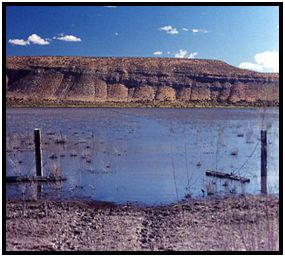 1a
1a 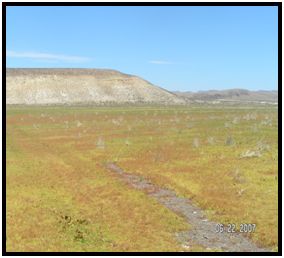 1b
1b
Figures 1a and 1b. The area treated with herbicide on June 9, 2007 to control perennial pepperweed seedlings during the first week of April, 2007 (1a) and on June 22, 2007 (1b). The brownish tint in photo 2b is the leaves of perennial pepperweed seedlings affected by the herbicide treatment.
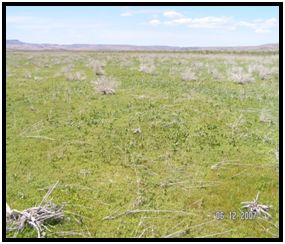
 2b
2b
Figures 2a and 2b. Landscape (2a) and closeup (2b) photos show the extent of perennial pepperweed seedlings on the recently exposed lakebed at Chimney Dam Reservoir on June 12, 2007, three days after treatment. The slightly taller broadleaved plants are perennial pepperweed.

Figure 3 . An example of the mature stand of perennial pepperweed (13 days after herbicide treatment) just above the high water mark and immediately east of (but adjacent to) the seedling population.
TREATMENT
Approximately 450 acres were treated with an aerial application of Cimarron® Max (metsulfuron methyl, dicamba and 2,4-D) at the labeled rate for perennial pepperweed. This equates to the following amount of active ingredients per acre: 0.60 oz metsulfuron methyl; 6.6 oz of dimethylamine salt of dicamba; and 18.9 oz of 2,4-D. The mix included a non-ionic surfactant at the rate of 0.25% v/v (1 quart per 100 gallons of spray mix). The application occurred on the morning of June 9, 2007 when the winds were calm, the skies clear and temperature about 73°F. There was no rain after the application for at least two weeks. High temperatures ranged from 83°F on the day of application to 97°F on June 17th, with low temperatures typically in the upper 30’s to mid 40’s at night. The last frost occurred in late May and the frost-free period lasted until September 11, 2007.
At the time of the herbicide application, the perennial pepperweed seedlings were four to six inches tall, had tap roots from about six inches to over 10 inches deep, and about 4 to 8 leaves per plant. In the mature stand of perennial pepperweed, plant maturity varied from very early bud to very early flowering, the recommended treatment period. Treatment at this stage has been successful at other locations in the vicinity (Schultz 2007). The top inch of the soil in the seedling population was dry, but the subsoil was moist at all depths. Drier soil occurred in the mature stand. Seedling counts occurred in 3 x 100 ft belt transects. In the mature stand of perennial pepperweed, occular estimation of percent control occurred at six locations. Prepeat photography also was used to document the effect of treatment.
RESULTS – Seedlings
The perennial pepperweed seedlings started to show the effect of the herbicide treatment within three days (Figure 4a) and appeared to have complete top-kill 13 days after treatment (Figure 4b). The perennial pepperweed’s elevated, brownish-purple, leaves were an excellent indicator of the short-term effect of the treatment. Visual observation several weeks after treatment found that over 99 percent of the perennial pepperweed seedlings showed signs of being adversely affected by the herbicide. Seedling counts for two years post-treatment found almost complete control (Table 1Figures 5a-5b). The carpet of annual forbs that co-occurred with the perennial pepperweed had been replaced largely with foxtail barley (Hordeum jubatum L.) and some seepweed (Suaeda sp). The success of this treatment persisted into 2010 (Figure 6).
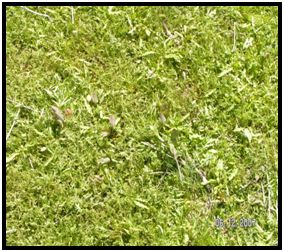 4a
4a 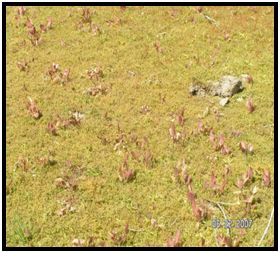 4b
4b
Figures 4a and 4b. Perennial pepperweed seedlings 3 (4a) and 13 (5b) days after treatment. The brownish hue in both pictures shows the extent of the herbicide’s effect on leaves on these two dates.
Table 1. Seedling density (number per 3 x 100 ft belt transect) and percent stand reduction in the mature stand of perennial pepperweed following application of Cimarron Max herbicide on June 9, 2007.
|
|
Seedling Population |
|
|
Mature Stand |
||||
|
|
Total Density in Belt Transect |
|
|
Percent Reduction2 |
||||
|
Transect |
20071 |
2008 |
2009 |
|
Location |
2008 |
2009 |
2010 |
|
1 |
127 |
0 |
0 |
|
1 |
5 |
25 |
85 |
|
2 |
108 |
0 |
0 |
|
2 |
10 |
30 |
80 |
|
3 |
162 |
0 |
1 |
|
3 |
5 |
40 |
80 |
|
4 |
275 |
1 |
1 |
|
4 |
10 |
35 |
90 |
|
5 |
187 |
0 |
0 |
|
5 |
1 |
40 |
85 |
|
6 |
243 |
1 |
1 |
|
6 |
50 |
50 |
80 |
|
Mean |
185 |
0.33 |
0.50 |
|
Mean |
16 |
37 |
83 |
.
1. Density at the time of herbicide application.
2. Percent stand reduction from the relative abundance observed in 2007.
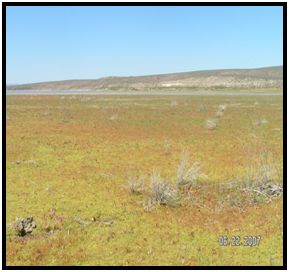 5a
5a 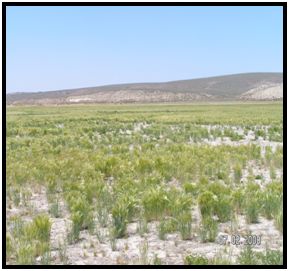 5b
5b
Figures 5a and 5b. The treatment area 13 days after treatment (5a) and one year later (5b). The brownish hue in figure 5a is the leaves of treated perennial pepperweed plants. The predominant species in figure 5b is foxtail barley, a short-lived perennial grass.

Figure 6. The area treated to control perennial pepperweed seedlings in 2007, three years later in 2010. There has been no re-establishment of perennial pepperweed. This figure is the same location shown in figure 5a.
RESULTS – Mature Perennial Pepperweed Stand
Treatment of the mature stand of perennial pepperweed was much less successful (Table 1 and Figures 7a and 7b). Visual inspection of the treatment area one-year post-treatment estimated control at less than 5 to about 50 percent at different points. As shown in Figure 7a, the residual perennial grasses were shorter than most of the pepperweed plants and did not interfere with herbicide delivery to the target weed. The chlorosis seen in Figure 7a shows a substantial short-term effect on the above-ground portions of perennial pepperweed, within two weeks of treatment in 2007. Figure 7b demonstrates that control one-year after treatment was ineffective in this meadow setting. After several more years of treatment this stand was reduced by about 80 to 90 percent and replaced with a vigorous stand of perennial forage grasses (Figure 8).
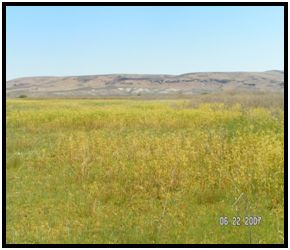 7a
7a 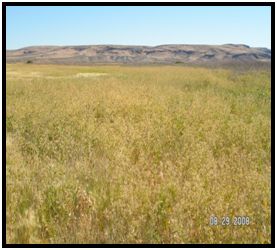 7b
7b
Figures 7a and 7b. The mature stand of perennial pepperweed 13 days after treatment (7a) and in August the following year (7b). There was evidence of extensive top kill in 2007 (yellowish chlorotic plants) but abundant regrowth in 2008.

Figure 8. The mature stand of perennial pepperweed in July 2010, after several follow up treatments. Perennial pepperweed is still present but represents a small portion of the plant community and is virtually unseen from a distance.
DISCUSSION
Mature plants of perennial pepperweed were widely scattered across the lakebed at Chimney Dam Reservoir before the lake started to refill in the back to back wet years of 2005-06. The area shown in Figures 1a-1b was underwater for at least 12 to 18 months. Rapid drawdown of the reservoir in the spring of 2007 clearly demonstrates that prolonged flooding (≥1-year) will kill mature perennial pepperweed plants but not the large viable seedbank. In 2007, the receding reservoir created hundreds of acres of bareground that was largely fine textured sediment. The moist, fine-textured soil combined with a wide diurnal temperature range to create an excellent germination and survival environment for the seed of perennial pepperweed. The perennial pepperweed seedlings, however, were much more susceptible to treatment with Cimarron® Max herbicide than was the adjacent stand of mature perennial pepperweed. The perennial pepperweed seedlings probably were more susceptible to the herbicide treatment for three reasons. First, the root size of the seedlings (Figure 9) undoubtedly was much smaller than that for mature plants (Renz et al. 1997, Chen et al. 2002, DiTomaso and Healy 2003). The seedlings in this study generally had fewer than eight leaves (Figure 9), which is the development stage by which perennialization typically occurs (i.e. develop buds: Renz 2000). Even if the roots had developed buds there would have been substantially fewer than on mature plants with extensive root systems. Second, the rapid growth exhibited by roots in perennial pepperweed seedlings requires substantial movement of new carbohydrates from the leaves to the root system. This large scale movement of carbohydrates from the leaves to the roots undoubtedly facilitated translocation of the active ingredients to the root system, facilitating death to most seedlings. Third, the leaves of the perennial pepperweed seedlings were elevated above all other vegetation and they had a broad relatively flat surface. This facilitated herbicide delivery onto the leaves and uptake through the leaf epidermis.

Figure 9. The extent of root growth of perennial pepperweed seedlings 3 days after treatment in 2007. This contrasts sharply with roots from mature plants than can reach 10 feet deep and over 10 feet of horizontal growth.
The mature stand of perennial pepperweed had nearly complete top-kill of the target weed (Figure 7a). Abundant regrowth the following year indicates that root- and perhaps crown- kill was non-existent. Numerous specific factors probably influenced the lack of success, but one very probable cause was that the 2,4-D and Dicamba in the herbicide mix rapidly reduced plant translocation. This could have reduced the amount of, or even prevented the metsulfuron methyl from being translocated to the buds on the roots. Both 2,4-D and Dicamba are auxin type herbicides that act quickly, often within days, in the leaves (Vencill 2002, Cobb and Reade 2011). Metsulfuron methyl moves slowly in the phloem and eventually accumulates in the buds in the roots where it inhibits acetolactate synthase, causing death of the plant (Cobb and Reade 2010). The mature pepperweed plants likely shut down or dramatically reduced translocation before the metsulfuron methyl could be fully moved translocated to all sites of action in the roots, thus, preventing plant death and preserving viable roots (and their stored energy) for regrowth the following year.
Weed seedlings, and particularly well exposed seedlings, are much easier plants to control. They present the most susceptible growth stage for large scale control and the best opportunity for a successful treatment application, chemical or otherwise. As perennial pepperweed (and most perennial weeds) mature many factors related to plant biology, physiology, developmental stage and plant architecture make successful treatment more difficult. These factors increase the probability for a partial to complete failure of any herbicide treatment. The plant architecture of perennial pepperweed by itself reduces the probability that the majority of the herbicide will be placed on the basal leaves, which are the leaves that have more of their carbohydrates translocated toward the roots. The results of this work clearly show that early detection of seedlings and rapid response for treatment is a critical component of a weed control program.
The cost of the Cimarron® Max application was about $22.00 per acre for chemicals and $8.50 per acre for aerial application. The observed treatment success for seedlings was estimated at over 99 percent, but as little as 5 percent for the long-established mature stand. The mature stand had sufficient density and spatial extent to require a full-scale follow-up application after the initial treatment: effectively doubling the cost of control. The results of this effort suggest that controlling perennial pepperweed at the seedling stage, regardless of the size or intensity of the infestation, results in better control and significant financial savings. An important follow-up question becomes: can 2,4-D, a much cheaper herbicide than Cimarron® Max or any other sulfonylurea herbicide known to control perennial pepperweed, be equally effective at controlling perennial pepperweed in the seedling stage.
Literature Cited
Chen, H., R.G. Qualls, and G.C. Miller. 2002. Adaptive responses of Lepidium latifolium to soil flooding: biomass allocation, adventitious rooting, aerenchmya formation and ethylene production. Environmental and Experimental Botany. 48:119-128.
Cobb, A. H. and J.P.H. Reade. 2010. Herbicides and plant physiology. Second Edition. Wiley- Blackwell. West Sussex, UK. 286 p.
DiTomaso, J.M. and E.A. Healy. 2003. Aquatic and riparian weeds of the west. University of California Press. Oakland, CA.
Laubhan, M.K. and T.L Shaffer. 2006. Seed germination of Cirsium arvense and Lepidium latifolium: implications for management of montane wetlands. Wetlands. 26:69-78.
Leininger, S.P. and T.C. Foin. 2009. Lepidium latifolium reproductive potential and seed dispersal along salinity and moisture gradients. Biological Invasions 11:2351-2365.
Miller, G.K., J.A. Young, and R.A. Evans. 1986. Germination of weeds of perennial pepperweed. Weed Science 34:252-255.
Renz, M.J. 2000. Element stewardship abstract for Lepidium latifolium L. The Nature Conservancy. http://www.imapinvasives.org/GIST/ESA/esapages/documnts/lepilat.pdf. Accessed October 7, 2011.
Renz, M.J. 2005. Perennial pepperweed. Lepidium latifolium. Pages 91-98. In: Invasive plants of range and wildlands and their environmental, economic and societal impacts. C.L. Duncan and J.K. Clark (eds.). Weed Science Society of America. Lawrence, KS. 222 p.
Renz, M.J. and R.R. Blank. 2004. Influence of perennial pepperweed (Lepidium latifolium) biology and plant-soil relationships on management and restoration. Weed Technology. 18:1359-1363.
Renz, M.J. and J.M. DiTomaso. 2004. Mechanism for the enhance effect of mowing followed by glyphosate application to resprouts of perennial pepperweed (Lepidium latifolium). Weed Science. 52:14-23.
Renz, M.J., J.M. DiTomaso, and J. Schmierer. 1997. Above and belowground distribution of perennial pepperweed biomass and utilization of mowing to maximize herbicide effectiveness. Proceedings California Weed Science Society 49:175.
Schultz, B. 2007. Paradise Valley weed control demonstration plots: perennial pepperweed. University of Nevada Cooperative Extension Special Publication 07-06. 17 p. Available at: http://www.unce.unr.edu/publications/files/nr/2007/sp0706.pdf
Vencill, W.K. (editor). 2002. Herbicide handbook. Eighth edition. Weed Science Society of America. 493 p.
Wotring, S O., D. Palmquist, and J. Young. 1997. Perennial pepperweed (Lepidium latifolium) rooting characteristics. Pages 14-14. In: T. Svejcar (ed). Management of perennial pepperweed (tall whitetop). Special Report 972, USDA Agricultural Research Service and Agricultural Experiment Station. Corvalis, OR: Oregon State University.
Young, J.A., D.E. Palmquist, and S.O. Wotring. 1997. The invasive nature of Lepidiumlatifolium: a review. Pages 59-68 in J.H. Brock, M. Wade, P. Pysek and D. Green, eds. Plant invasions: studies from North America and Europe. Leiden, The Netherlands: Backhuys.
Young, J. A., C.D. Clements, and R.R. Blank. 1998. The ecology and control of perennial pepperweed. Weed Technology 12:402-405.
